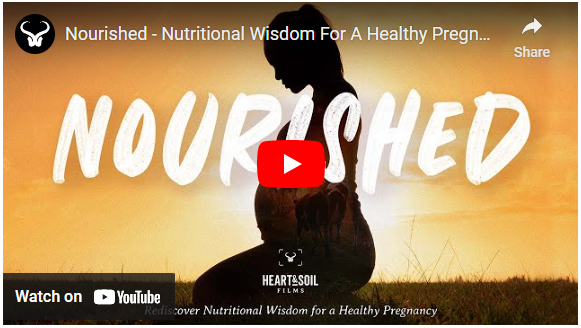
Published on January 26, 2022 by Ashley Rothstein our fertility journey
If you’re reading this blog post because you are trying to conceive (or are thinking about trying to conceive), congratulations! Trying to conceive a baby can be an exhilarating time filled with hope and excitement. But it can also be filled with stress and multiple unknowns, especially if it’s a new process for you.
For me, I was just about to turn 31 when my husband and I began trying to conceive our first baby. Since we want at least a few kids, I didn’t want to waste any time. So, when it came to month 1 of us trying, I went in guns blazing.
Believe it or not – I got pregnant three months in a row. I didn’t know such a thing could happen until it did.
In this post, I’m going to cover the things we did – before, during, and after trying to conceive – that (I think) led us to successfully getting pregnant every month the first three months we tried (crazy, right? I still think so), to now having a little girl growing in my belly almost 23 weeks later!
And note: The post is entitled “Conceiving on an Animal-Based Diet.” While eating an animal-based diet and loading up on crucial nutrients is a factor that I think largely contributed to our success with fertility, it’s not the only piece of the puzzle. I do touch upon animal-based eating and supplementation here, but this post is about way more than that.
Update: I had my baby! Read my full birth story here or check out the pregnancy section on my website for more animal-based pregnancy, birth, postpartum, and motherhood resources. our fertility journey
Heart & Soil Films featured our story in their mini-documentary, Nourished, which spotlights animal-based pregnancies. Click on the above image to watch it on YouTube.
Before conceiving
When I stroll down memory lane, five things come to mind when I think about what we did in preparation to conceive:
- We got our lifestyles and health habits in order.
- We tested for certain health markers.
- I learned about my menstrual cycle.
- I learned about the conception process.
- We purchased ovulation strips to be used during the conception process.
I’ll expand on these five things below. our fertility journey
Lifestyle & health habits
There are a million things that contribute to a healthy lifestyle. When I think about what being “healthy” means, these are the buckets that immediately come to mind:
- having a nutrient-dense diet
- conscious supplementation
- maintaining proper hydration and electrolyte balance
- limiting alcohol consumption
- limiting caffeine consumption
- minimizing toxins in the products you use
- sleeping well
- adequate sun exposure
- consistent movement
- having meaningful relationships
- having meaningful work
- managing stress
- dealing with past trauma
- nurturing your spirituality and connection with a higher good/self/force
Managing all of these buckets successfully is incredibly complicated and looks different for everyone.
I can’t speak for you and what your buckets look like, but for me, I spent a great deal of time and energy in recent years doing what I can to manage and optimize my buckets. Same goes for my husband. I think this is a factor that set us up for success in trying to conceive, as it all plays a role in one way or another. our fertility journey
When we started our fertility journey, we both had a good handle on our consumption. We were…
- eating nutrient-dense diets,
- consciously supplementing,
- maintaining proper hydration and electrolyte balance,
- limiting alcohol consumption*,
- limiting caffeine consumption*,
- and minimizing toxins in the products we used.
To elaborate on this, here are some details…
Diet
While trying to conceive, my husband and I were both eating solid animal-based diets. To see how I define our animal-based diet, check out the first section in this post here. Before animal-based, we tinkered in and out of keto, carnivore, and paleo. I’ve read that keto can be amazing for fertility (especially for women), but both my husband and I are high-stress individuals. We found keto to be stress-inducing on our bodies and not sustainable. It was a great metabolic reset for us, but we felt way better after switching over to an animal-based diet. We were eating an animal-based diet for about 6 months prior to trying to conceive (and still do to this day), so our bodies were packed with nutrients. our fertility journey
Supplementation
We also ditched the manufactured supplements we were taking and began taking loads of organ supplements. Read more about our regimen here. In addition to this regimen, my husband was also taking Ancestral Supplements MOFO (equivalent to Heart & Soil Whole Package). I considered taking Heart & Soil Supplements Her Package, but I’ve heard mixed things about it. Some women say it helped regulate their cycle/hormones, and others say it screwed up their cycle/hormones. It felt best to avoid, just to be on the safe side.
Note: If you’re looking for an organ supplement source that is cheaper than Heart & Soil but still high quality, consider Perfect Supplements. They offer a multi-organ blend and a desiccated liver supplement. You won’t get the targeted support that you do with Heart & Soil, but these are great alternatives. Perfect Supplements also offers both products in bulk powders. Use ASHLEYR for 10% off at checkout. our fertility journey
Already an organ supplement veteran? Use my discount codes for 10% off your entire order.*
For Heart & Soil, use ASH10 at checkout for 10% off.
*Note: discount code does not work with Heart & Soil subscription.
Hydration & electrolytes
We were both drinking/eating tons of water, salt, and electrolytes. Salt is so, so, so, so, so important. I have said this a million times, but increasing my salt intake is one of the best things I have ever done for my health. My husband and I often joke that we don’t know how we lived without eating and drinking loads of salt before. Read more about that here. our fertility journey
Alcohol & caffeine consumption
I don’t drink alcohol or coffee and I never really have. This is a factor that (I think) majorly set me up for success since I have heard that both alcohol and caffeine can hinder fertility. *Also, this is anecdotal, but I find this interesting: the first two months I got pregnant, I had very early miscarriages (chemical pregnancies). During both of these months, my husband was drinking a lot of caffeine and a moderate amount of alcohol. He went on a 45-day alcohol and caffeine cleanse prior to our third month trying, and that’s the month we ended up being successful. I have heard that alcohol and caffeine can hinder sperm quality, so that’s something to consider. our fertility journey
Minimizing toxins
I spent the last couple of years drilling down and getting better when it comes to our sourcing for things we use every day…things like toothpaste, deodorant, shampoo, makeup, and household cleaning products. Many skincare and household products contain harmful ingredients that are endocrine disrupters. I’m not exactly sure how they play a direct role, but I hear endocrine disrupters can mess with fertility. Check out this post to learn how you can replace your everyday household items with better animal-based alternatives, this post to learn how to detoxify your home from harmful substances, and this post to learn about a transformative experience I had with lard-based shampoo.
Update: I have product guides available now that may be of interest to you. I created them to help people source nutrient-dense food and replace conventional products with lower-toxic alternatives. Check them out here. our fertility journey
Other factors
The better we nourished our bodies with proper food, hydration, electrolytes, and clean products, the better we slept. This paid back in spades when it came to our energy, mood, and well-being.
And in regards to the sun exposure and movement buckets, we’re always trying to get out in the sun and move more. Modern-day life makes this difficult, and my husband is better at prioritizing this than me. It’s a “one foot in front of the other” sort of effort, but it’s always on both of our minds.
And as for the relationships, work, stress, trauma, and spirituality buckets, those are also always on our minds, in our conversations, and are works in progress.
I believe lifestyle factors feed directly into fertility – into the health of a woman’s cycle, the health of a woman’s eggs and uterus, the health of a man’s sperm, etc.
So it’s important to do an inventory check on your own lifestyle factors when it comes to trying to conceive.
But with that being said…
Humans were built to reproduce, and I don’t think the process is as fragile as we sometimes think it is.
There are some people with horrible diets, who smoke and drink alcohol regularly, who use toxic products and rarely move or get out in the sun…that are able to conceive seemingly effortlessly.
And there are others who are trying really hard to do everything right and still have trouble conceiving.
I often wonder if there is some mystery factor when it comes to health and conceiving – perhaps a cosmic factor – that none of us fully understand. Read the book Spirit Babies if you’d like to dive down this rabbit hole. our fertility journey
Testing for certain health markers
My husband and I were feeling pretty good health-wise going into our fertility journey, but I wanted us both to take a few health tests to make sure that everything was running smoothly internally.
We don’t go to conventional doctors anymore, so I sought out at-home health testing.
We checked our thyroid markers, vitamin D levels, metabolic health markers, and my husband checked his testosterone levels…easily, from the comfort of our own home. No questions from doctors and full control for us.
LetsGetChecked is the at-home health testing service that we use, and they have a plethora of tests (way more than listed above) if you want to check any of your own markers.
I have a code for 30% off any test (ASHLEYR) if you end up using them. It’s a lifetime code and will work for any test.
Some of my other favorites are the essential vitamin test, omega 3 test, minerals test, micronutrient test, kidney test, liver test, iron test, prostate test, and Celiac disease test.
For us, a big one was the testosterone marker. For years, my husband always wondered if he had low testosterone since he dealt with fatigue issues. Low testosterone could have been a troublesome factor for us during the conception process, but a simple test showed us that was not the case and he was rockin’ at 771.
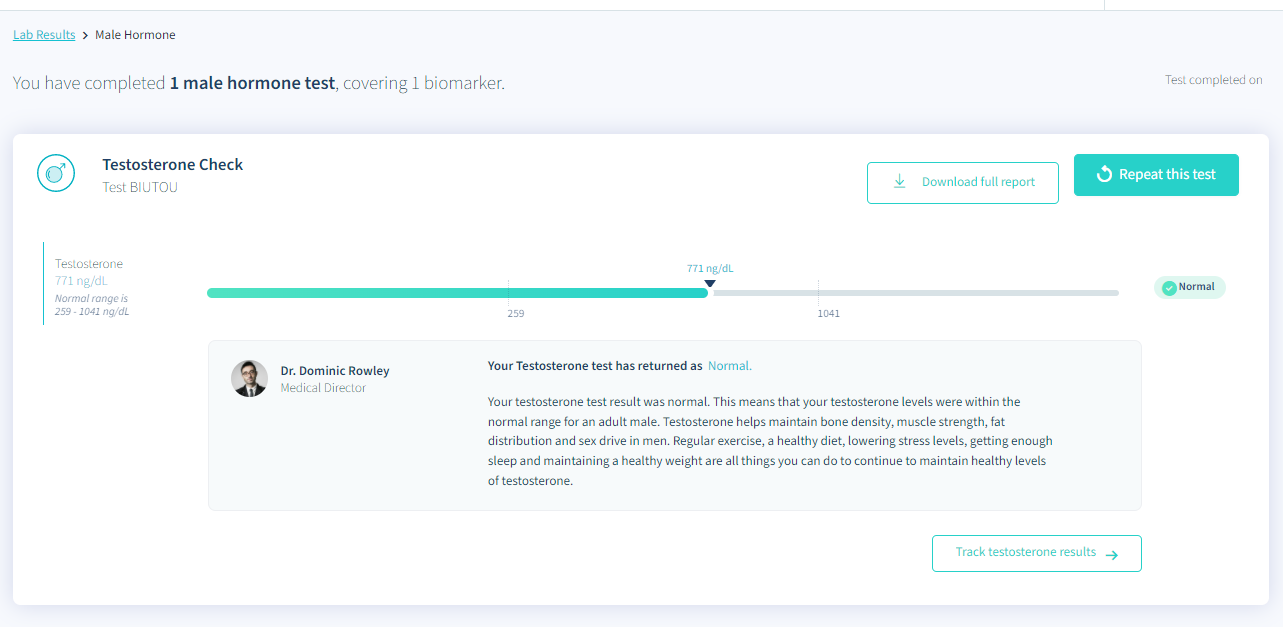
Knowing where we stood for the health markers that mattered to us made us feel confident going into our fertility journey. our fertility journey
Learning about my cycle
I have a friend with a “unicorn” menstrual cycle (as she calls it). It comes every 28 days on the dot, without fail. That is not my menstrual cycle.
My cycle has never been consistent. Some months, it was 28 days. Others it was 26. Others it was 34. At its highest, it was over 50 days. I used to think this was a malfunction. Because my cycle was irregular, I assumed I would have problems conceiving one day. So I decided that the next step for me was to learn more about it.

So I tracked my cycle for about two years. Over time, I saw its irregular nature not as a malfunction, but instead, as a factor of life.
Some months I was more stressed, not hydrating as well, or overexercising. Other months I ate different foods, took different supplements, or ate more or less of a certain macronutrient group. This all affected my cycle, and I learned I could use this data to help further calibrate and optimize my health.
As I improved my lifestyle factors and tweaked certain things, my PMS and periods got easier and easier. And I started to feel more and more confident in my reproductive health.
I began to pay attention to my cervical mucus and notice how it changed during different parts of my cycle. And how in the various phases of my cycle, I felt different physically, emotionally, and spiritually.
My cycle never became entirely predictable and regular, but as I started to pay attention to it, I began to understand it more. And the more I understood it, the less it scared me, and the more confident I became as a woman getting ready to reproduce.
The menstrual cycle is an amazing health marker for a woman, and for any woman trying to conceive, I highly recommend she learn about her own cycle. our fertility journey
A note about cervical mucus: Most sources say that women are the most fertile when they have slippery, clear, jelly-like cervical mucus that is similar to the consistency of an egg white. This means you’re ovulating or ovulation is very close. I have observed this type of cervical mucus during my cycle before, but oddly enough, I didn’t really see it at all during our entire conception journey. I’ve heard that if you have sex prior to ovulation (which we did), this can skew what your cervical mucus looks like. And also, as you get older, you can have less of the egg white cervical mucus and still ovulate. So a note to those tracking their cervical mucus: if you don’t see egg white cervical mucus, this does not automatically mean you did not ovulate.
Learning about the conception process
If you go down the Google rabbit hole of fertility research, there is a ton of information and a lot of it is conflicting.
In sorting through it all, I found the following pieces of data that helped me better understand the conception process:
- Circulating sperm may be of better quality than stagnant sperm, as long as the sperm isn’t circulating too often. What this means: old sperm and new sperm may be less optimal than sperm in between. Many sources recommend having sex every 2-3 days leading up to a woman’s fertile window, then every day or every other day during her fertile window. This ensures that a man’s sperm is circulating through at a decent pace and is not sitting too long or being pumped out too quickly.
- A woman’s fertile window is 5-6 days before she ovulates. Having sex during the 5-6 days before a woman ovulates will increase your odds of conceiving successfully.
- Women are the most fertile 1-2 days before they ovulate and while they are ovulating. Having sex during the 1-2 days before a woman ovulates and while she is ovulating creates the highest odds for conception.
- Women have an LH surge, an LH peak, and then ovulate. These three markers are important to pay attention to if you’re tracking ovulation. Sources say a woman’s luteinizing hormone (LH) begins to surge 24-48 hours prior to ovulation, will peak 8-20 hours before ovulation, then she will ovulate, and the egg will hang around for 12-24 hours. More on how to use this info in the next section.

- There are other things you can do that may increase the likelihood of conceiving. Things like laying with your hips elevated after sex, the woman orgasming after the man, having sex in certain positions, and using certain lubricants are said to increase conception odds. These things may work, but we never tried any of them.
Purchasing ovulation strips
I will talk about these more in detail in the next couple of sections, but prior to our first month trying, I purchase ovulation strips as I wanted to have them on hand and ready to go once we were ready.
These are the strips I used. They were easy to use and cheap. our fertility journey
During the conception process
When it comes to the actual conception process, three things come to mind when I think about what we did during:
- used ovulation strips to learn about my LH surge/peak + ovulation patterns
- had sex regularly before my fertile window + got busy during my fertile window
- took care of our bodies and managed stress as much as possible
Ovulation strips
When it comes to conceiving, some couples prefer to go about it more freely and be surprised. AKA no tracking, planning, etc. I think this is great if that’s your thing! For me, because of my age, I wanted to be more strategic about it.
That being said, demanding that your husband have sex with you before he goes to work because you think you’re about to ovulate is not sexy for anyone – you or him. So there is definitely a balance here. 🙂
If you use the ovulation strips, they’ll show you when your LH starts to surge and when it peaks. Remember these two tidbits I mentioned in the previous section?…
- Women have an LH surge, an LH peak, and then ovulate. These three markers are important to pay attention to if you’re tracking ovulation. Sources say a woman’s LH begins to surge 24-48 hours prior to ovulation, will peak 8-20 hours before ovulation, then she will ovulate, and the egg will hang around for 12-24 hours.
And…
- Women are the most fertile 1-2 days before they ovulate and while they are ovulating. Having sex during the 1-2 days before a woman ovulates and while she is ovulating creates the highest odds for conception.
Takeaway: If you see your LH begin to surge, ovulation is likely 24-48 hours away. This is when you’re most fertile and when you have the highest chance to conceive. So when you see that LH surge on your ovulation strip, it may be a good idea to get busy. And if you see your LH peaking on your strip, ovulation is very close. Have sex asap!
Note: I included photos of my ovulation strips in the section below so you can get a visual of what I’m talking about.
Also…
If you track your ovulation over a few months, you may start to see patterns. For instance, I noticed my LH peaked around day 18 or 19 during the first two months I tracked, so I assumed I was ovulating on day 19 or 20. Remember this from the previous section?…
- A woman’s fertile window is 5-6 days before she ovulates. Having sex during the 5-6 days before a woman ovulates will increase your odds of conceiving successfully.
Once I saw a trend in my LH surge/peak, I was able to determine my fertile window without having to track my LH surge/peak. The third month we tried, I didn’t track at all. Since I assumed I was ovulating on day 19 or 20, I concluded my fertile window was during days 14-20 or so…so we just did the deed multiple times during that window, and it worked! our fertility journey
Having regular sex
I think there is both a scientific component to this and a spiritual one.
If you’re having regular sex, your odds of conceiving will increase simply due to how numbers work. This is the science.
But how and why you’re having sex – in my opinion – also plays a role. Is the sex forced to achieve a result, or is it mutually desired? This is the spiritual.
To start with the science, I ask you to recall this data point from the last section…
- Circulating sperm may be of better quality than stagnant sperm, as long as the sperm isn’t circulating too often. What this means: old sperm and new sperm may be less optimal than the sperm in between. Many sources recommend having sex every 2-3 days leading up to a woman’s fertile window, then every day or every other day during her fertile window. This ensures that a man’s sperm is circulating through at a decent pace and not sitting too long or being pumped out too quickly.
We followed this plan to the best of our ability. I’m not a fan of making sex mechanical, but the circulating sperm idea made sense to me, so I went with it.
Now, for the spiritual…
Sex is one of those things that doesn’t work as well when it becomes a job. The more force you exert toward planning it, the more mechanical it becomes, and the more you lose the spice, zest, and all the magical things that makes good sex amazing.
There’s a lot in life that we don’t know or don’t see, and I believe there is a cosmic component to love-making, sex, and reproduction.
Out of the three months my husband and I tried to conceive, the third month is the month we were successful, and that is the month I felt the freest from planning and exerting force on the process because I didn’t track my ovulation or use the HCG strips. I don’t think that’s a coincidence.
The more information you have, the more you know. And the more you know, the easier it is to strategize. When you’re strategizing, you can formulate a path for probable success before acting, but you’re not operating from an expectation-free zone. And expectations – if not managed properly – can create force and strain.
Gathering information, planning, and acting strategically can all be good things, but too much of anything can turn into a bad thing. Balance is key here.our fertility journey
Taking care of yourself
During the three months we tried to conceive, a few very stressful personal events occurred. Both my husband and I experienced a great deal of stress, so I’m actually surprised I got pregnant three months in a row…especially since the “fails” the first two months compounded and stressed me out even more.
Remember the lifestyle factors I talked about at the beginning of this post? Because both my husband and I have made them a priority in recent years, we understand how important they are to our well-being. And they’re always on our radar…even during times of stress.
So while neither of us is close to perfect when it comes to taking care of ourselves, it’s something we’re always thinking about and working toward, even during the hard times.
Stress puts the body in a catabolic state (a state of breaking down) and can wreak havoc on your system. Doing your best to take care of yourself during times of stress is important, especially when it comes to conceiving. When you’re trying to conceive, you’re trying to build a human. And building is the opposite of breaking down.
Now that I’ve covered the nuts and bolts of what we did to prepare, I’m going to walk you through the three months of our fertility journey and what I learned from them. our fertility journey
Month 1:
Month 1. Boom.
I had my ovulation strips and was ready to test. In the Amazon reviews, some women recommended starting to test after getting off your period. Since I didn’t have any data at this point, I followed that advice and started testing on day 7. This was right after my period stopped that month.
This is my strip from day 7:

The first line is the test line and the second line is the control line.
If the test line is lighter than the control line (like on my day 7 strip), your LH has not yet surged or peaked.
Once the test line starts to get as dark as the test line, your LH is starting to surge. Ovulation is likely 24-48 hours away. This happened on day 17 for me:

And once the test line gets darker than the control line, your LH is peaking. Ovulation is likely 8-20 hours away. This happened on day 18 for me:

On my chart below, you’ll see that I started to surge on day 17, peaked on day 18, and came back down on day 19. Since ovulation occurs 8-20 hours after LH peaks, I assumed that I ovulated sometime on day 19.

This month was tricky because we had family staying with us in our tiny little apartment during my entire fertile window, so we weren’t able to have sex then. We ended up having sex on day 18 – the day of my LH peak – and on days 19 and 20 for good measure.
Note: Since a woman’s egg hangs around for 12-24 hours after it’s released, you still have a chance to successfully conceive if you have sex the day of your peak. If you have sex on the days leading up to your peak, you may have better odds for success, but sperm can reach the woman’s fallopian tube in as little as 45 minutes. So if you’re in a bind, it’s worth a shot.
Because of the timing and circumstance, I figured maybe we were too late this month. And in that case, we wouldn’t be successful. I really had no idea what to expect since this was our first go-around. I have friends who got pregnant their first month trying and others who have been trying for a long time and still have not gotten pregnant, so it felt like a toss-up.
In the days after, I micromanaged my body… probably a bit too much. If you look closely, you’ll see a bunch of notes on my chart.
Via Google, I figured out when implantation would likely be happening based on when I ovulated. I started to feel some cramping and wondered if it was implantation cramping. I had mild pressure in my pelvis and abdomen on and off for 1-2 weeks. My boobs started to hurt way more than they usually did prior to my period. I felt hot on and off and experienced some intense mood fluctuations. I also had some potent nightmares. There was definitely something happening in my body. While I wasn’t sure exactly what, it felt like something was different.
As you’ll see on my chart, I started to test for pregnancy (the kit I bought comes with HCG strips too) around day 25, just 6 days after I ovulated. This was way too early. If you use an early detection pregnancy test, most people will get a positive result the day of their missed period. And sources say you should wait AT LEAST 10-14 days after you ovulate (this is usually around when you’re supposed to get your period), if not longer, before you test for pregnancy.
But I wanted to know so badly.
Our 3-year wedding anniversary was coming up on the day I was supposed to get my period, which was day 34 of my cycle. I figured that would be a perfect day to tell my husband that I was pregnant. I hadn’t gotten a positive test yet, but because of what I was feeling in my body, I started to become optimistic that I was pregnant.
Because I was up against this self-set deadline, I became impatient. I was anxious every day when it came time to test, and it’s all I started to think about.
When I get anxiety, sometimes my bladder becomes extra sensitive. I pee before I actually need to and it’s usually dilute urine. Dilute urine can skew a pregnancy test result, so whenever I peed out dilute urine, I would get mad at myself, chug more water, and wait to pee again. Sometimes I would gamble and test the dilute urine, just to find a negative result. This would make me angrier.
These were not some of my best days.
Starting on day 31, I started to see a very, very, very faint line in the testing line spot.

For the HCG strips, any line (even very faint) means positive, so I became even more optimistic.
But I really had to squint to see it, so I doubted myself. I spent so many minutes looking at those damn lines in different lighting, with flashlights, etc., that I started to wonder if I was seeing things or if the line was really there. On day 32, I saw the faint line again. At that point, I figured it must mean something.
On day 32, I went to the store to get a few early detection pregnancy tests. This was on Sunday, and my anniversary was on Tuesday. At this point, I assumed I was pregnant, so I also bought a little gift (a special candle) that I would use to tell my husband I was pregnant on our anniversary.
I came home, tested, and boom. A faint line. I was pregnant! (top test in the below photo)
I took another test from a different company. Boom..another faint line! I was definitely pregnant. (bottom test in the below photo)
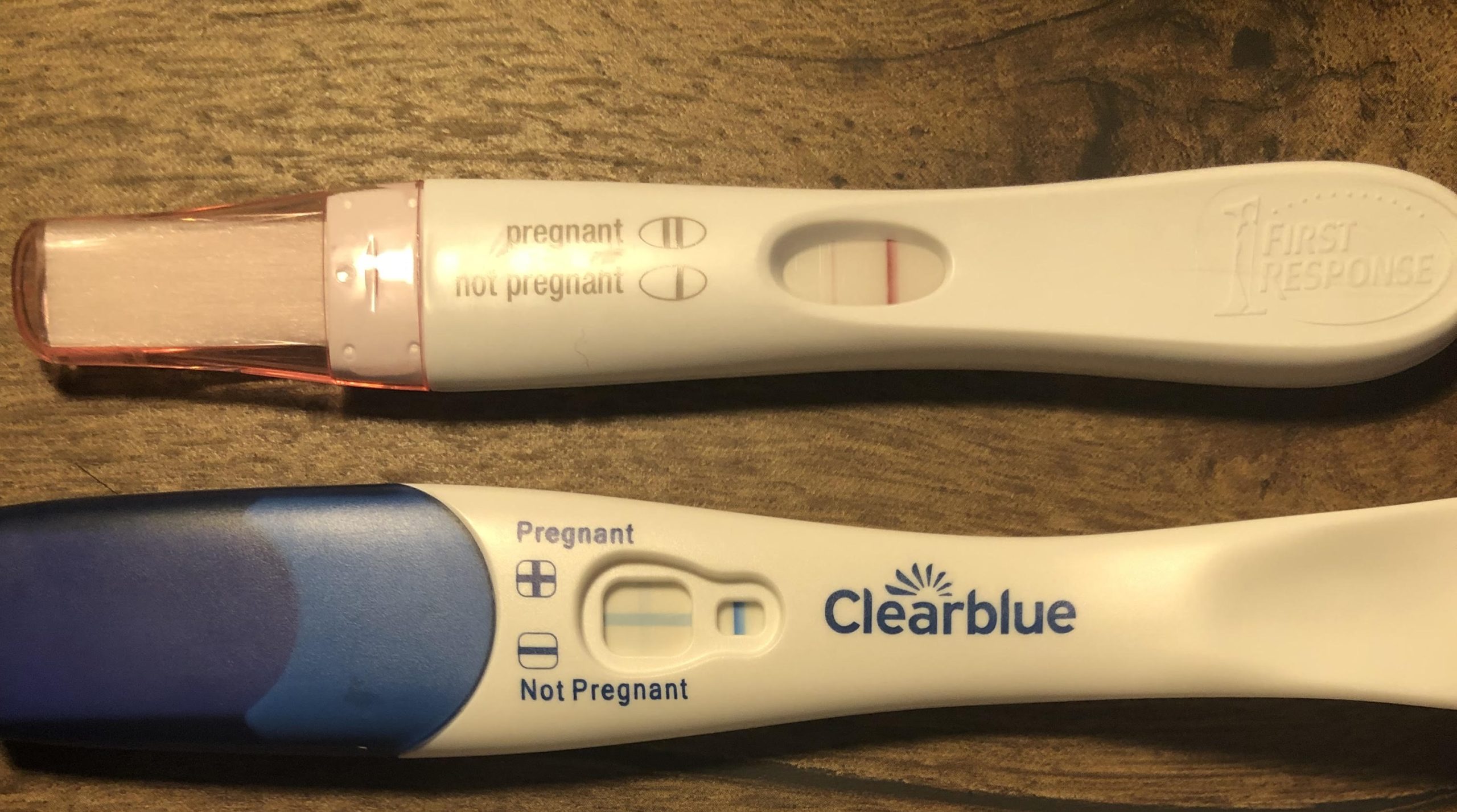
I was excited, but for some reason, I doubted myself. In hindsight, I wonder if this was because the pregnancy was already failing, and perhaps my intuition was trying to tell me so.
I woke up the next morning (day 33) – the day before our anniversary – filled with doubt. But me doubting myself is not a new thing, so I wondered if I was just in my head about it. The night prior, I started to have some intense cramps that continued throughout the morning. I held on to the idea that these were implantation cramps since I had been having them on and off, but I decided to take another test just to be sure.
The line was there (barely), but was fainter than the line from the test the day before.

I had a feeling this wasn’t good. HCG is supposed to double every day during the beginning of pregnancy, so in theory, the line should be getting darker every day. I considered that maybe my urine was a bit more dilute that day compared to the day before, but it was impossible to tell.
The fainter line coupled with the doubt I felt didn’t make me feel great. I still had the cramps, but held on to the narrative that they were implantation cramps.
Since I was set on telling my husband the following day that we were pregnant, I started to become very nervous. I wrote out a card to him as if I was pregnant, but every step of the way something inside told me that I wouldn’t end up successfully pregnant this time around.
Later that day, I started to bleed. My cramps began to really intensify, beyond what I was used to feeling during my period. I still held on to the idea that they were implantation cramps (and now implantation bleeding). My intuition told me that they weren’t, but I didn’t want to listen.
That night, I ended up telling my husband what was going on. I told him that I was pregnant, but now bleeding and cramping, and that I had a bad feeling something not good was happening.
I went to sleep that night clinging on to the last little bit of hope I had. Throughout the night, the cramps intensified so much that it hurt immensely to lay on my back. My bleeding intensified as well. I woke up somewhat panicked and turned to Google. “Chemical pregnancy.” Boom…an answer. That’s what had happened.
A chemical pregnancy is a very early-term miscarriage. The sperm fertilizes the egg and the embryo begins to attach to the woman’s uterus, but there is an error somewhere in the process – usually due to chromosomal abnormalities in the egg or the sperm – and the embryo does not successfully attach to the uterus. It is expelled in the same process as a miscarriage. This happens right around when women are supposed to get their period, usually around week 4 or 5. Unless a woman is testing early for pregnancy (like I did), most won’t even know it happened because it just feels like a heavy period.
So, I ended up miscarrying on our anniversary. It was painful both physically and mentally, but it humbled me. As weird as it may sound, I felt like I needed it.
I ended up testing again the following morning, and I was met with two negative pregnancy tests:
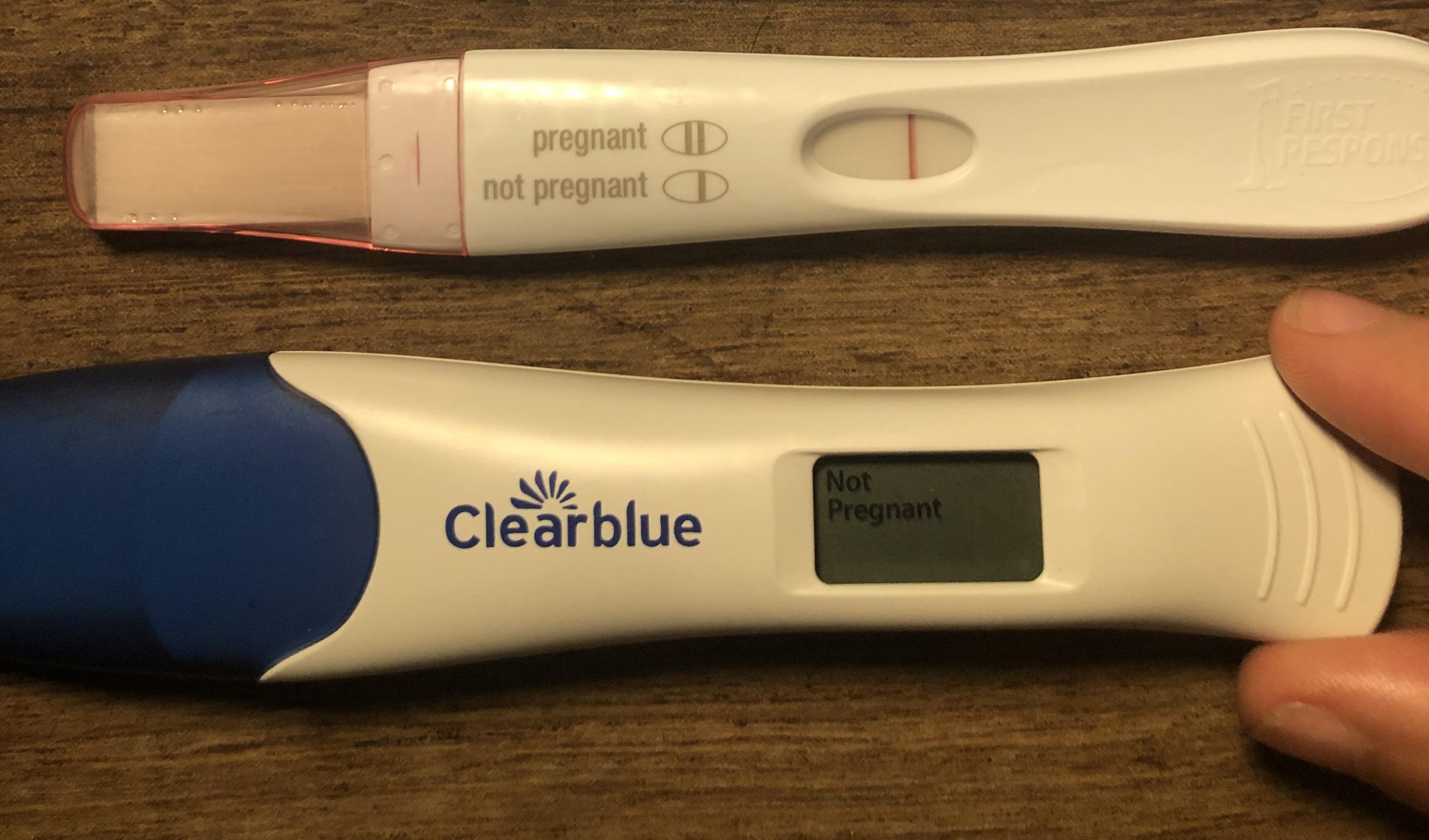
This was the closure for month 1. our fertility journey
Month 2:
Month 1 was really sad, confusing, and hit me like a ton of bricks. I cried a lot and felt a lot.
Like I said, it was painful, but I felt like I needed it. It felt like a purge of some sort.
When I reflected, I concluded that I was putting too much force and pressure on the process, and I needed to surrender somewhere.
But having experienced the first chemical pregnancy, fear now seemed to taint everything. The process no longer felt pure and exciting. It felt like some sort of test that I could fail again.
I decided that I would do the ovulation strips again to get the data, but that I would sacrifice the HCG strips. I told myself that I wouldn’t test for pregnancy until I missed my period that month.
Here are my ovulation strips from month 2:
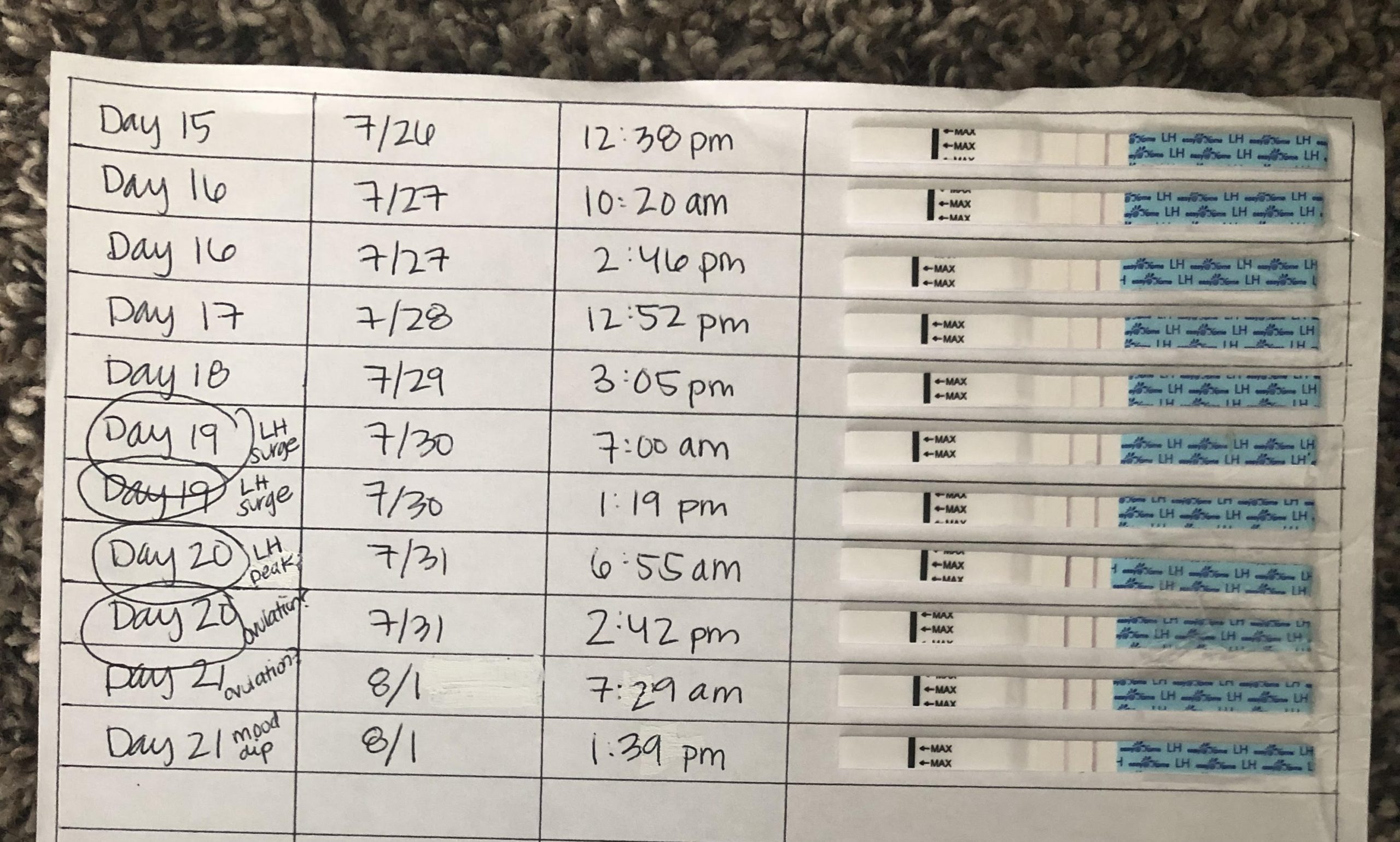
I started to surge on day 19, peaked on day 20, and came down on day 21, so I likely ovulated on day 20.
This month, we didn’t have any family visiting, so we had way more sex during my fertile window. I felt optimistic.
I kept my promise to myself and did not use the HCG strips during month 2. Thank goodness, because in hindsight I realized how horribly stressful using them during the first month was.
I paid attention to my body closely again and the same sort of things happened – cramping, boob pain, feeling hot, mood stuff, pelvic pressure, nightmares. I felt pregnant again.
It took an incredible amount of willpower to not test for pregnancy during the two-week waiting period. I was anxious and wanted to know so badly. As each day crept on, I grew more and more scared to see blood. I even started to become nervous to go to the bathroom and pee!
It was the day before I was supposed to get my period – day 33 of my cycle – and I saw some brown blood on my underwear. This freaked me out.
But during the prior month, I had red blood immediately. So because this was brown blood, I figured it may actually be implantation bleeding this time around.
But I was too impatient to wait and see. So I caved and took a pregnancy test.
The line didn’t show up in the first couple of minutes, so I got frustrated and threw the test away. But after a few more minutes, something told me to go take the test out of the garbage. So I did, and saw a faint line. I was pregnant again!
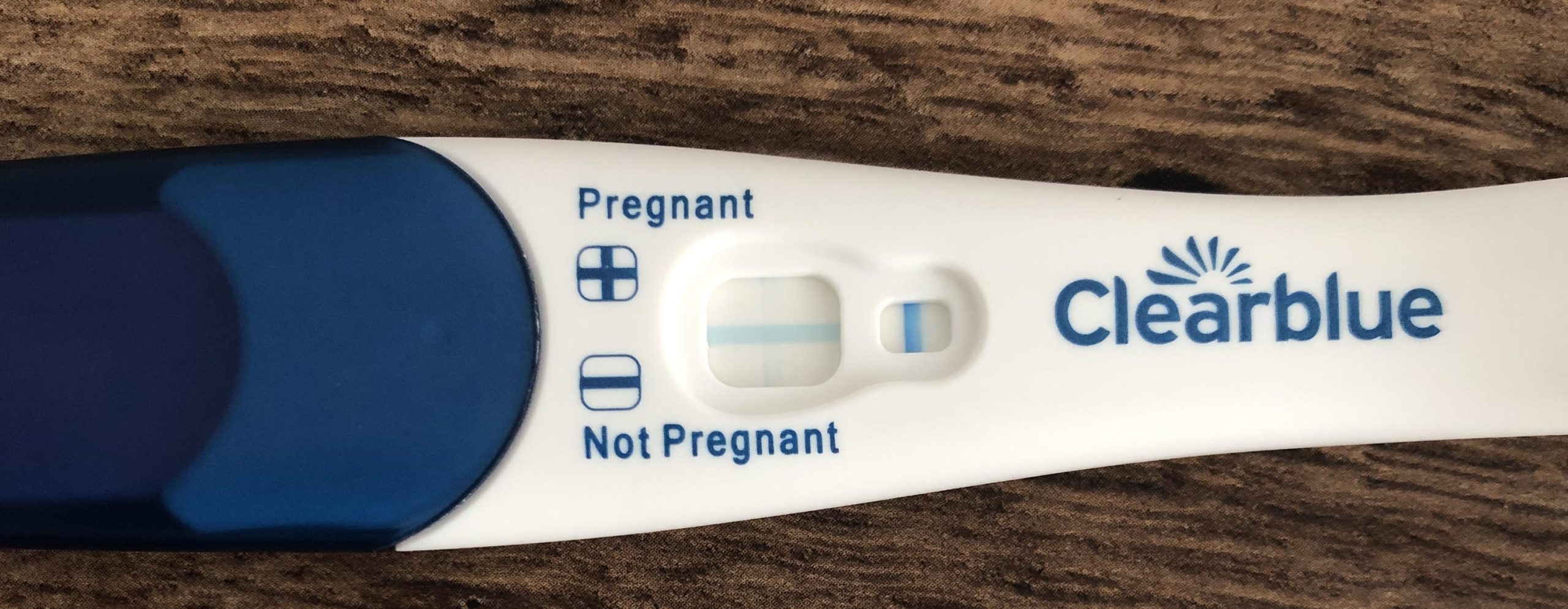
Funny though, because I had the same sort of doubt I felt the prior month. Something just didn’t feel right. It’s like I was trying too hard to make this happen instead of letting the process be.
The brown blood continued throughout the day. Then like an eerie flashback, I got the intense cramps again. They intensified even more overnight – just like the last time – and the brown blood turned into red blood the following day.
The horrible cramps and bleeding continued, just like in the prior month.
I have to say…the bleeding and cramping during these two months were entirely different from my normal periods. I sympathize with women who have miscarriages. The process is physically painful and emotionally taxing. And my miscarriages were so early on. I can’t imagine the pain that a late-term miscarriage brings.
I ended up testing again the following day. Stark white. This confirmed it had happened again – another chemical pregnancy. our fertility journey
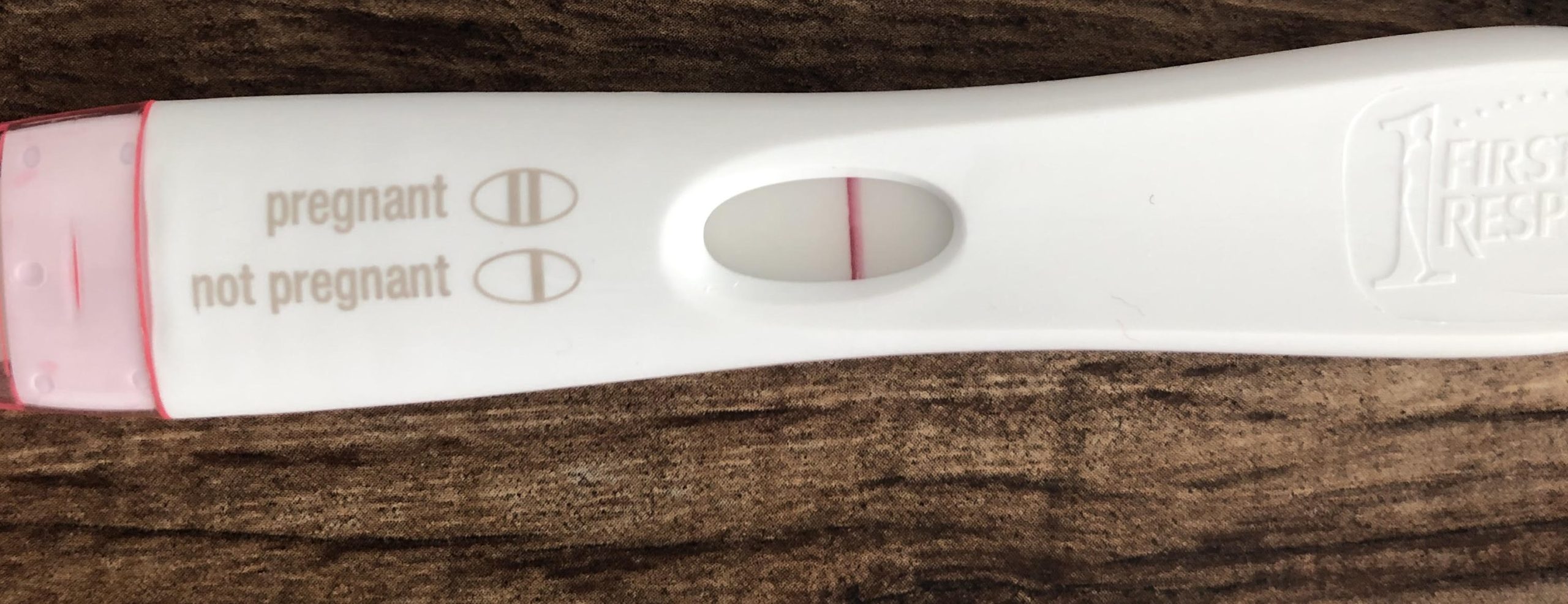
Month 3:
I went into month 3 feeling very defeated. But because I felt so defeated, it seemed like the only thing left to do was surrender.
But this felt impossible. I am someone who, by design, likes to control everything. So the thought of surrendering the testing, pressure, strain, and force made me feel scared. I felt like if I didn’t do any of that, we wouldn’t be successful. If I let go, then I’d miss my fertile window, my husband and I wouldn’t have enough sex, we’d be too early or late, or I would do something wrong.
But testing again felt more stressful than not testing. So I sacrificed the ovulation testing altogether and told myself that I would see how I felt about the pregnancy testing once the time came.
Because I had the data from the prior two months, I assumed that I would ovulate around day 19 or 20. From that, I assumed my fertile window would be around days 14-20.
My husband and I had a ton of sex around that time, and I felt freer. Maybe we nailed it, or maybe we missed it. Not knowing was somewhat exhilarating. I had a good feeling we did enough, but the not knowing felt free. It felt better. I felt lighter. It felt like a great balance between having enough information to strategize, but not micromanaging to the point of stress.
As the days went on, I started to feel pregnant again. I had gotten familiar with the feelings the last two months and was starting to become a pro at detecting the early signs.
I wasn’t sure if it was the liberation I was experiencing, but not only did I feel pregnant, I also felt that this would be the month. Couldn’t tell ya why, but I just felt it.
I ended up testing twice the day before I was supposed to get my period, and I got two positives. Pregnant a third time!
Month 3 was the first month I was confident using a digital test (the test that displays words, not lines) upfront.
I couldn’t find the courage during the two prior months to bear my emotions if I were to see the words “Not Pregnant” on a test, except for when I knew I knew I was no longer pregnant after the chemical pregnancies. The little lines were always easier to swallow, I guess.
But not this month…I somehow found the courage in month 3. Or maybe it was just cosmically there.
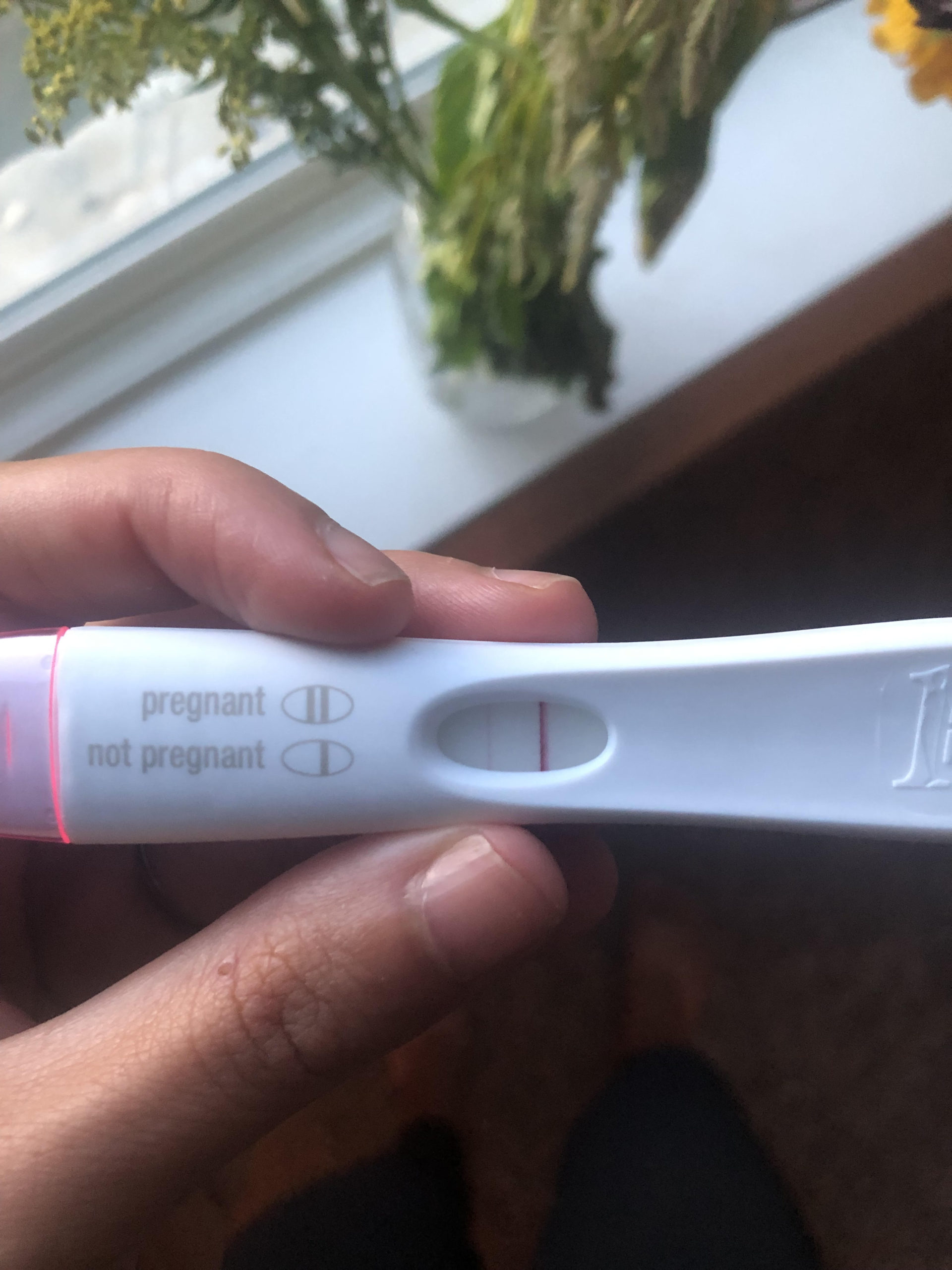

I would be lying if I said I was not very anxious in the weeks following these two tests. But I had no bleeding, no intense cramping like the prior two months, and generally speaking, I just took things one day at a time.
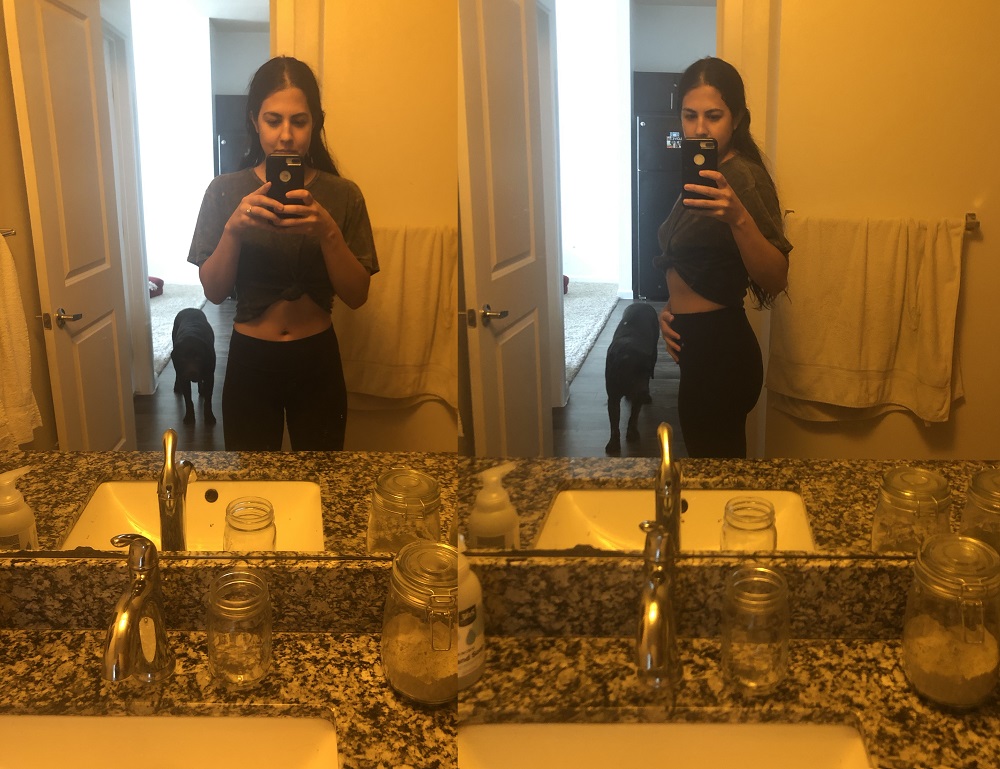
The day I found out I was pregnant. 🙂
And now I’m here, almost 23 weeks in, and pregnant with a little girl.
And she’s kicking (or punching – hard to tell yet) as I write this. 🙂
Through research sometime during month 3, I learned that when a woman is in her 20’s, about 25% of her eggs are not viable. This means that three months out of the year, her eggs will have chromosomal abnormalities and will not lead to a viable pregnancy. When a woman hits her 30’s, about 40% of her eggs are not viable. The number continues to creep up from there with age.
I was 30 when we first started trying. This meant that about 40% of my eggs were not viable. So 4-5 months out of the year, my eggs would not lead to a successful pregnancy.
Experiencing the two chemical pregnancies in a row made me question my fertility. I started to wonder if I was infertile in some way, or if this would just keep happening over and over and over again.
But it didn’t. When I learned that my eggs wouldn’t be viable 4-5 months out of the year – and that this was just a fact of life – this eased my mind a bit.
And when I zoom out, I now see it as amazing that my body was able to get pregnant three months in a row. Even though the first two months didn’t work out, my body was doing exactly what it was supposed to do.
If only I could have just seen it then…
Life never seems to work like that though. 🙂
Final thoughts
Every fertility journey is different. While your journey will be different than mine, I hope you found the information in this post useful.
When I was in the pits of the “fails” the first two months, I was down in the dumps and wondering if I would ever get pregnant.
Now, I’m getting ready to give birth in just 4 months!
Update: I had my baby! Read my full birth story here or check out the pregnancy section on my website for more pregnancy, birth, and postpartum resources.
It’s still surreal to look at the progression of our ultrasound pics. Here’s the progression from just under 6 weeks, to 7.5 weeks, to 10 weeks, to 20 weeks.

And here’s a close up of her most recent mug shot 🙂 and the shot that revealed her gender to us!

Every time I see the last photo, I can’t help but stare at those cheeks. 🙂
Best of luck to you on your fertility journey. If you have any questions, do not hesitate to reach out to me at asheatsgood@gmail.com.
For more animal-based pregnancy, birth, postpartum, and motherhood resources, check out my Pregnancy hub. our fertility journey

